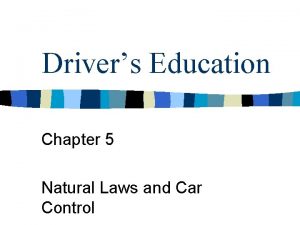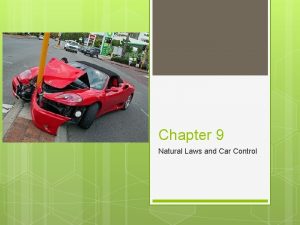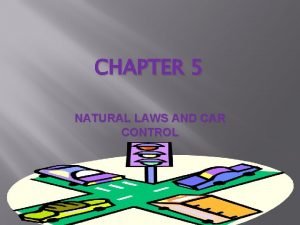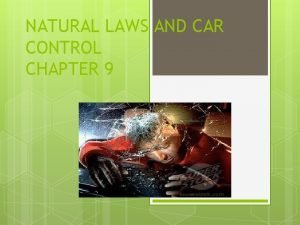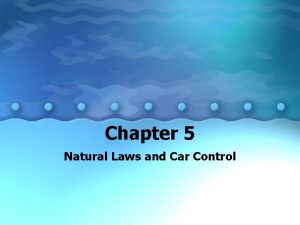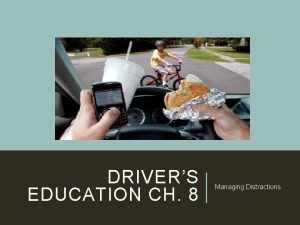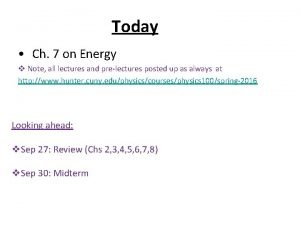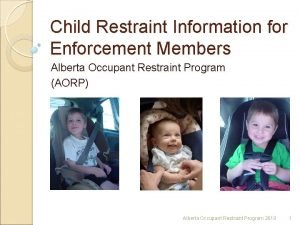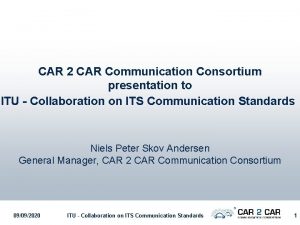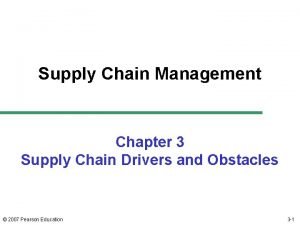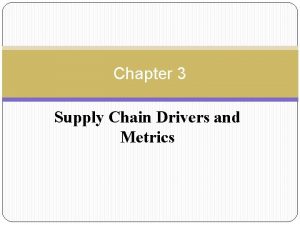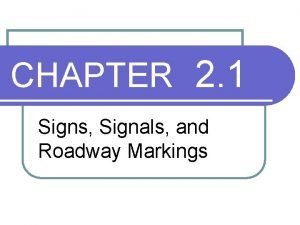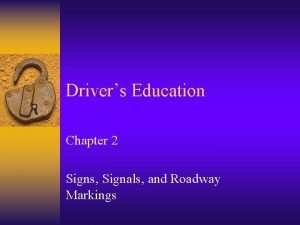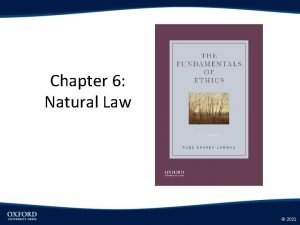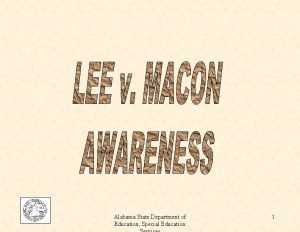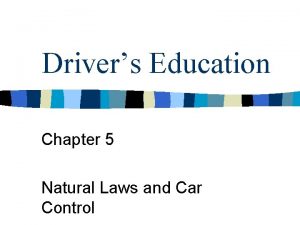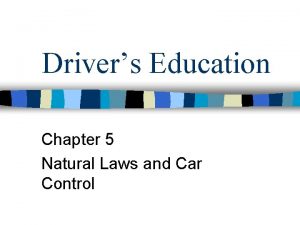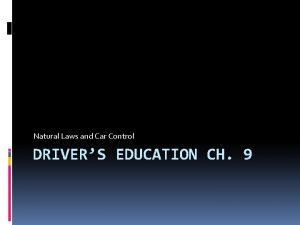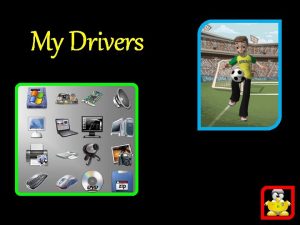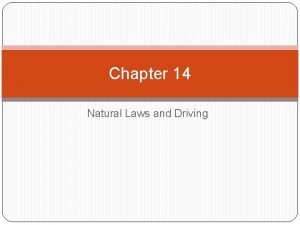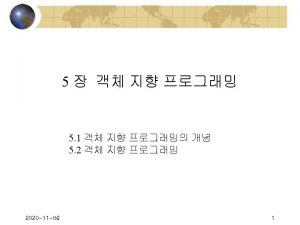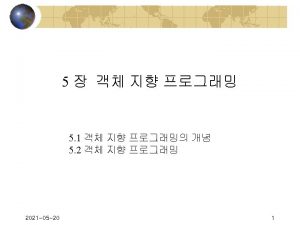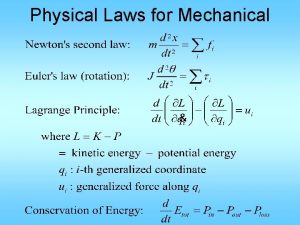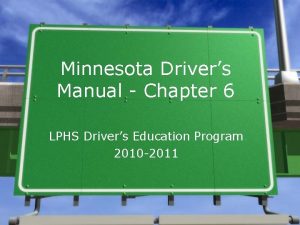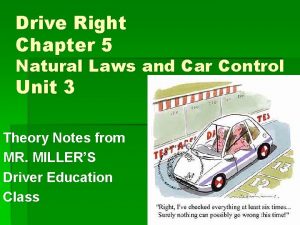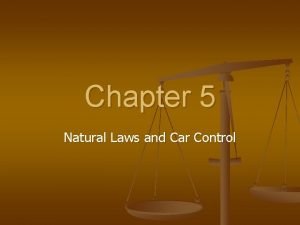Drivers Education Chapter 5 Natural Laws and Car




















- Slides: 20

Driver’s Education Chapter 5 Natural Laws and Car Control

Gravity – is the force that pulls all things to the earth n Driving up hill – your vehicle will lose speed. You must increase power to overcome gravity and maintain speed n Driving down hill – your vehicle will pick up speed. You must coast or shift to a lower gear to maintain speed n

Energy of Motion(Kinetic Energy) – is energy acquired when an object moves. n When load weight doubles, energy of motion will double. Then the vehicle will need to twice the stopping distance. n Energy of motion will change in proportion to the square of its change in speed. If speed doubles, you will need 4 times the stopping distance. If speed triples, you will need 9 times the stopping distance n

Traction n Traction – friction created by tired on the road surface. n Friction – is the force of two surfaces in contact, this keeps each tire from sliding off the roadway.

Tires Tread – Grooved surface of a tire that grips the road. n When the road is wet the tread allows water to flow through the grooves and away from the tire. n A tire’s ability to grip the roadway will increase with the amount of tread touching the road. n

Blowout – is when all the air escapes from the tire at once. n This may happen as a result of the tire being bald or from a puncture n

Tire Inflation Each tire is design to work properly at a certain air pressure. n Underinflation – only the outside edges of the tire contact road, can cause uneven tire wear. n Overinflation – only the center will contact the road. Will wear more quickly and decrease traction n

Reduced Traction Vehicle Condition n Good shock absorbers are important for maintaining traction. Worn shock absorbers will cause your vehicle to bounce of the road. n Worn tires will limit your control. n Road Surface n Wet, Icy, or rough roads can greatly reduce traction. n When road surface is poor reduce speed for more control n

Checking Traction Check rear zones to make sure no traffic is near. n Brake to see how the vehicles responds. n If your vehicle does not slow or if your antilock brakes start to work then reduce your speed. n

Vehicle Control in Curves Speed – to reduce your chance of skidding, lower your speed before entering a curve n Sharpness of Curves – the sharper the curve the more traction your vehicle will need to grip the road. Use slower speeds for sharp turns n Banked Curves – is a curve that is higher on the outside than on its inside. This will help the vehicle grip the roadway better. n

Vehicle Control in Curves Load – the greater the load of a vehicle, the slower the vehicle will have to go around a curve. n Vehicles with a high center of gravity will flip easier in curves n

Stopping Distance Total Stopping Distance – is the distance your vehicle travels while you make a stop. n This is measured from when you first see a hazard to the point where your vehicle stops. n Reaction Time – the length of time it take you to identify a hazard and begin to slow. n Reaction Distance – this is the distance your vehicle travels during this time. n

Stopping Distance n Braking Distance – the distance your vehicle travels from the time you apply the brakes until you stop.

3 Second Rule 1. Pick a fixed checkpoint – like a shadow over the road or a sign where you think that you could stop. When the car in front of you passed the checkpoint. n 2. Count off 3 seconds: “one-thousand, two one-thousand, three-one-thousand, fourone-thousand. ” n If you pass the checkpoint before you finish counting you are to close to the vehicle in front of you. n

Factors That Affect Braking Distance Speed – the higher your speed to longer your braking distance. n Vehicle Condition – worn tire and shock absorbers takes longer to stop n Road Surface – rain, snow, ice, dirt, wet leaves, and gravel will increase stopping distance. n Driver Ability – if you are distracted or impaired it will take longer to stop. n Hills – when driving downhill stopping distance will increase. n Loads – heavy loads will increase braking distance. n

Force of Impact – force with which a moving object hits another object. n Speed – most important factor in determining how hard a vehicle will hot another object. n Weight – the heavier the vehicle, the more damage it will cause. n Distance Between Impact and Stopping n

Safety Belts Three collisions occur when a vehicle hits a solid object. n 1. Vehicle hits object and stop. n 2. Occupant either hits inside of the vehicle or restraint devices. n 3. Occupants may suffer internal collision as their organs impact inside of the body. n

Restraint Devices Passive Restraint Devices – like an air bag, works automatically. n Active Restraint Device – one you have to engage, like a safety device. n

Other Safety Devices Airbags – a balloon like device that inflated automatically to protect you. n Front and rear crush areas – vehicles are now designed to crush on impact. n Reinforced Windshield – to avoid flying glass in a collision, vehicles has laminated windshields. n

Other Safety Devices Padded Dash – this can reduces injury in all crashes. n Child Seats – special seats for infants or small children. Must be used in the rear seat and used properly. n Head Restraints – padded head rests on the top of seats to protect against whiplash. n
 Chapter 5 natural laws and car control worksheet answers
Chapter 5 natural laws and car control worksheet answers Chapter 9 natural laws and car control
Chapter 9 natural laws and car control Chapter 5 natural laws and car control
Chapter 5 natural laws and car control A vehicle's momentum depends on its
A vehicle's momentum depends on its Chapter 5 natural laws and car control
Chapter 5 natural laws and car control Qq moves
Qq moves Distractions outside the vehicle are more easily managed
Distractions outside the vehicle are more easily managed Ch7on
Ch7on Charles de secondat
Charles de secondat Forward facing car seat alberta
Forward facing car seat alberta Ed ch
Ed ch Car to car communication consortium
Car to car communication consortium Drivers of supply chain management
Drivers of supply chain management 6 supply chain drivers
6 supply chain drivers Drivers ed chapter 2 signs signals and roadway markings
Drivers ed chapter 2 signs signals and roadway markings A short section of corrugated roadway that warns of hazards
A short section of corrugated roadway that warns of hazards Natural law ethics examples
Natural law ethics examples Natural law theorist
Natural law theorist Natural law ethics
Natural law ethics Natural income
Natural income Alabama special education laws
Alabama special education laws
